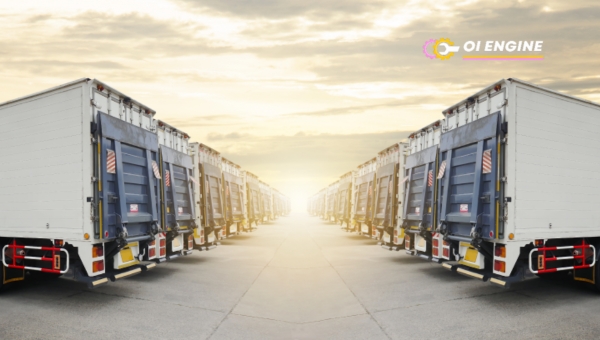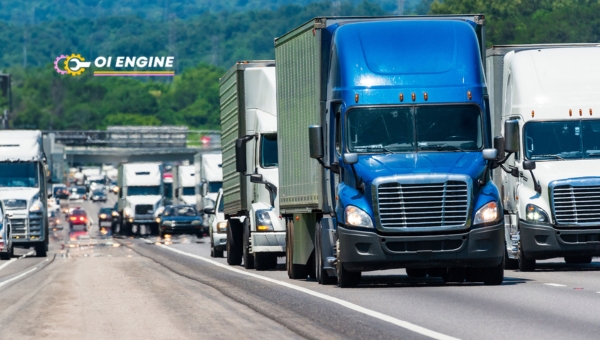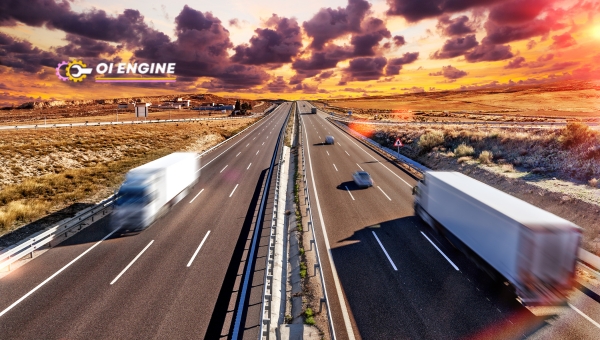As the backbone of America’s vast economy, understanding automotive freight movement is crucial. You may ask yourself which developments are reshaping the trucking industry? That’s where current and future Trucking Statistics come into play.
Offering clear insights and a temperature check on industry transformation, these data-backed indicators can prepare us to face new challenges and opportunities.
The trucking industry has seen its share of ups and downs in recent years, but it remains strong. In 2022, trucks transported 61.9% of ground freight between the US and Canada and a whopping 83.5% with Mexico amounting to $948 billion in goods across North America alone!
Moreover, trucking jobs have also shown substantial growth; with an impressive addition of 405,000 jobs in 2022 itself.
Present Condition of the Trucking Sector
The current state of the trucking sector is one of robust economic activity and significant growth. This bustling industry plays a pivotal role in our everyday lives, delivering goods across regions and powering the economy.

Not just within cities, but across national borders as well, trucks lead freight movement, accounting for a significant portion of trade with neighboring countries.
Trucking Statistics Of The Industry
The magnanimity and indispensability of the trucking industry are reflected aptly through various statistics. For instance, I find it incredible that in 2022 alone, trucking represented 80.7% of America’s freight cost!
That’s nearly $940.8 billion from this industry only! And when we talk about international trade, it’s predominantly trucking that stands out too.
In 2022 itself, trucks moved more than half (61.9%) of ground freight between America and Canada and an impressive 83.5% with Mexico.
Now let us reflect upon employment generation within this mighty industry; it’s sky-high! As per data from last year (2022), 405k new jobs opened up compared to the preceding year – that put some solid 8.4 million people into employment related to truck driving!
Feel like guessing who these fresh employees might have joined? It’s probably here where things get slightly surprising for some folks!
The majority (if not all) have ended up with small companies- to be exact- 95.8% of carriers that use ten or fewer trucks have welcomed them aboard! Believe it or not: nearly all fleets (99%) operate under a hundred trucks!
Federal taxes also come into play when dealing with fuel commodities and their implications on associated businesses – especially those primarily dependant on such resources for operations––like our vastly spread trucking network spread over North America worth $948 billion–– demanding gallons upon gallons of diesel!
This brings us to note an interesting statistic coincidentally from the summer of last year. The federal tax on each gallon of diesel was estimated at around 24 cents only!
It’s fair enough to state that trucking is a vast and bustling industry with millions employed across thousands of fleets dominated by small businesses.
The financial burden and challenges do prevail with taxation on fundamental resources like fuel impacting costs.
Also Read: Top 12 Semi-Truck Financing Companies 2024
Major Industry Relying on Trucking
Talking about industries that heavily rely on trucking first brings agriculture to mind. According to recent data, agricultural products represent an astounding 82.7% of goods transported via trucks. It is impossible to overstate how vital truckers are to farmers and vice versa; these road warriors transport grains from farms to storage facilities or directly to markets intending to feed millions.
Next comes dairy, fruits, vegetables, and nuts falling under our daily necessities category. Get this – a staggering 92% of these perishables rely solely on trucks for transportation!
Able to keep them cooled during transit with powerful refrigeration units while delivering them swiftly and efficiently – trucks do offer unparalleled service.
One might think that pharmaceutical products would have a lower percentage given their lightweight nature and non-bulk quantities – but brace yourself! A surprising 65% of all pharmaceutical products also hit the road in our dependable iron horses.
This includes all over-the-counter medications you can snatch off your local pharmacies’ shelves as well as important vaccines we need during pandemics or influenza outbreaks.
If trees could drive (what an imagination!) then maybe they could deliver themselves but unfortunately for us (and thankfully for nature), lumber and wood product manufacturers need substantial help transporting their goods- meeting this requirement is none other than your friendly neighborhood tractor-trailers!
Handling a mind-boggling total of 91.9% of delivery for this industry, trucking’s significant role can’t be overstated.
Data on Owner-Operators in Trucking
Truck owners who self-dispatch their commercial vehicles to haul freight are classified as owner-operators. As of 2022, they make up a major chunk with nearly 1.7 million actively operating within the U.S.
Using their equipment gives them greater control over the loads they haul, where they travel, and most importantly when they take home time – adding towards our understanding of how well respected this business model is within the trucking industry.
Often opting for long-hauls (trips covering a thousand and more miles) to maximize returns – approximately 351,000 owner-operators have carved out successful careers in this manner – showing off impressive entrepreneurial skills!
Becoming an owner-operator isn’t something people step into right from scratch though; most had prior experience working as company drivers before making the switch at around age 38.
For instance, an astounding fact tells us that the current average age of our nation’s entrepreneurial truckers stands at 59 – revealing a common trend in mature skilled labor choosing this path.
Another interesting piece of data sheds light on gender representation within this sector – with 6% comprised of women!
Although less than one might expect considering recent trends across multiple sectors urging for equal opportunities on work floors – it is certainly uplifting seeing these brave ladies challenging traditional norms while delivering excellence down open roads.
Accidents involving trucks often make headlines due to their gravity-defying size and weights – our diligent owner-operators however are known for maintaining stringent safety standards that are reflected via some encouraging data.
They boast an impressive record of being involved in merely 78.5 crashes per 100 million vehicle miles traveled which stands more than two times below national averages!
Maintaining such superior records surely has its rewards: stable annual income streams. In fact, as of July 2023, their average net incomes were reported around the $63,114 mark although this represents a slight 9% dip from the previous year.
Owner-operators are invaluable cogs in our logistic machinery who keep our economies thriving and at times saving our lives via time-sensitive deliveries; they truly deserve a big trucker salute!
Employment Trends In the Trucking Industry
People make industries run smoothly, and in 2022, we had an admirable workforce driving this sector forward.
With 8.4 million people working different jobs within this essential industry – it isn’t just about driving as evident with trucking employment shooting up by 405,000 more workers than the previous year.
One can hardly ignore how truckers played a leading role here with their numbers hitting 3.54 million professional drivers actively participating on our roads by the last count-me-down year-end: December 2022!
Women are gaining representation too; they now make up 8.1% which may not seem huge at first glance but then consider how much it has grown from even five years ago – something worth celebrating! The majority is minorities at 45.%, showing how diverse we’re becoming as a community.
Diversity doesn’t stop among drivers alone; it extends into companies that operate these vehicles too! For instance, about 96% operated ten or fewer trucks while almost all (99%) ran no more than one hundred rigs at most!
Driver wages have become a considerable part accounting for 32% while driver benefits accounted for another small chunk which was around 8% of all trucking-related expenses in points.
Fuel is also second to wages; it bit a significant 28% of all costs in this sector. But despite these numbers, finance issues ranked high on trucking industry surveys conducted in 2023; they shared the economy as their top concern, while fuel prices were not far behind, ranking as the third most pressing issue at the moment.
Also Read: Trailer Interchange Coverage-Protect Your Fleet!
Anticipated Trends in the Trucking Industry for 2025
Looking into the crystal ball of the trucking industry, I observe complex trends shaping up for 2025.

As we venture through uncertain times, economic fluctuations, supply chain challenges, and recruitment struggles are expected to dominate the scene. Yet, within these complexities lie opportunities for growth and innovation.
Ongoing Economic Uncertainties
Technically speaking, no sector is immune to economic uncertainties – but trucking takes a direct hit every time. Trucking is like the lifeblood of our economy with trucks moving crucial goods across great distances daily.
As such, fluctuations in fuel prices or sudden changes in trade policies can greatly impact our business plans and bottom lines.
Overcoming these hurdles won’t be an easy walk especially as forecasted Trucking Statistics indicate an ecosystem grappling with dynamically changing indicators. The trickling impacts can shake up everything from freight rates to driver wages.
We aren’t sitting ducks here! Thoughtful planning coupled with flexible strategies would prepare us better for any surprises that the economy may throw at us in 2025.
Challenges in the Supply Chain and Building Resilience
Ah! Supply chains – those intricate webs that connect producers to final consumers; they run straight through the heart of trucking operations.
A single hiccup anywhere along this complex system can echo thunderously across every mile covered by those big wheels. Indeed, disruptions on account of unexpected adversities (like pandemics or natural disasters) are glaring realities today.
Building resilience against such unforeseen shocks is even more crucial than before. Our aim must be to design robust systems that flex and adapt while continuing to deliver high service levels under varying condition scenarios in 2025!
Recruitment Struggles in the Transportation Industry
Attracting and retaining a skilled workforce is a jigsaw puzzle that the trucking industry has been trying to solve for quite some time now.
Between long hours, extensive travel, and the physical demands of the job, trucking isn’t an easy profession to opt into. This further compounds our recruitment struggles in this space.
Expanding workforces might pose a major hitch given the evolving demographics and growing emphasis on work-life balance. In particular, we need more younger folk to view trucking as a viable career choice.
In 2025, I hope initiatives such as competitive pay scales, robust training programs, employee wellness offerings, and advanced technological aids could help boost driver enrollment numbers.
Moreover, attracting more diverse demographics – like women drivers or individuals from various cultural backgrounds, can also introduce fresh perspectives in traditional work methodologies here.
Hopefully, with the right strategies employed timely, we all will counter these recruitment struggles effectively in 2025!
Endurance of Online Retail (E-commerce)
The rise of online shopping isn’t a new trend but it shows no signs of slowing down. With e-commerce booming, more goods than ever need to be transported to customers’ doorsteps.
This sustained demand places the trucking industry at the heart of fulfilling these orders, guaranteeing our continued relevance even as other sectors change and adapt.
Secondly, as e-commerce grows so does competition among companies wanting to offer customers speedy shipping solutions.
The need for fast delivery times can only be met by an efficient trucking sector making smart use of logistics tools.
This necessity pushes us constantly forward towards innovation which is just one way that online retail continues to shape our industry.
Also Read: Safeguard With 8 Top Occupational Accident Insurance
Pursuing Sustainability Goals Through Electrification
With increasing awareness about environmental concerns globally, it’s evident that our sector will have a significant role in pursuing sustainability goals come 2025.
Electrification is certainly on every agenda here – transport makes up a vast proportion of greenhouse gases released into our atmosphere and transitioning away from fossil fuels is not just preferable but crucial.
Making strides towards complete electrification won’t be easy – it requires investment in infrastructure including charging stations along common truck routes as well as creating trucks capable of handling long journeys whilst still being energy efficient.
However difficult though it might be; I am optimistic we can tackle this issue with vigour and determination proving once again how adaptable our industry is when faced with global challenges.
Expanding Technology Infrastructure and Ensuring Cybersecurity
In the modern age, a trucking company isn’t just about trucks – it’s about data too. Expanding technology infrastructure is a key trend for 2025 to keep up with increasingly complex logistics requirements.
The interconnectivity of those in the supply chain, driven by IoT devices, provides us with the necessary information to optimize route planning and delivery times.
As technology usage expands so does the threat of cyber-attacks. Therefore strengthening cybersecurity measures is equally essential.
We must safeguard our vital infrastructures so that sensitive data is protected and business operations are not disrupted due to cyber threats.
Global Political Influence and Implications
Trucking is not just a domestic industry now–it’s a global one. As we move closer to 2025, different political climates will inevitably impact trucking operations around the world.
Issues like fluctuating fuel prices, tariff negotiations, and trade agreements can all directly influence how well our industry performs.
The influence runs on both ends – as massive contributors to their economies, local and global policies are starting to accommodate the demands of the trucking sector.
responsibility in supporting other industries has given us an increased political importance that will play a significant role in shaping the future landscape of this industry.
So when it comes to anticipating what 2025 holds for our field, it’s clear that we can’t overlook these ever-changing political climates.
As active participants in this global network of trade and commerce, we need to stay alert and responsive to whatever new challenges or opportunities may come our way.
FAQs
What are the statistics of truckers?
Based on the available trucking statistics, by 2023, there were already 3.54 million professional truck drivers in the US. This marked an increase of around 405,000 from the previous year.
What is the biggest problem in the trucking industry?
Financial concerns often top the list of challenges in this industry, with fuel prices and economic uncertainties serving as primary issues. Additionally, finding ample parking for trucks is a significant concern among drivers.
What is the trucking trend in 2025?
The main trends expected for 2025 encompass increased reliance on technology and sustainability initiatives. The industry will likely observe considerable adaptations to shifting consumer demands and new advancements in digital tools.
Is trucking a growing industry?
Yes, despite various challenges, including economic uncertainties and supply chain complexities, projections show that total freight tonnage will increase significantly over time. It is anticipated to grow by approximately 28% from now until 2032.
Also Read: Safeguard With Physical Damage Insurance Coverage
Conclusion
The trucking industry continues to be the lifeblood of the country’s economy. Its trends and forecasts for 2025 highlight an industry ready to embrace challenges and seek innovative solutions.
Despite ongoing economic uncertainties, supply chain disruptions, recruitment struggles, and geopolitical implications, there is an evident drive toward resilience.
The growth of online retail, changing consumer demands, and the pursuit of sustainability through electrification signal a vibrant future.
Moreover, technology improvements seem set to boost productivity while ensuring enhanced security measures are upheld across the industry.
